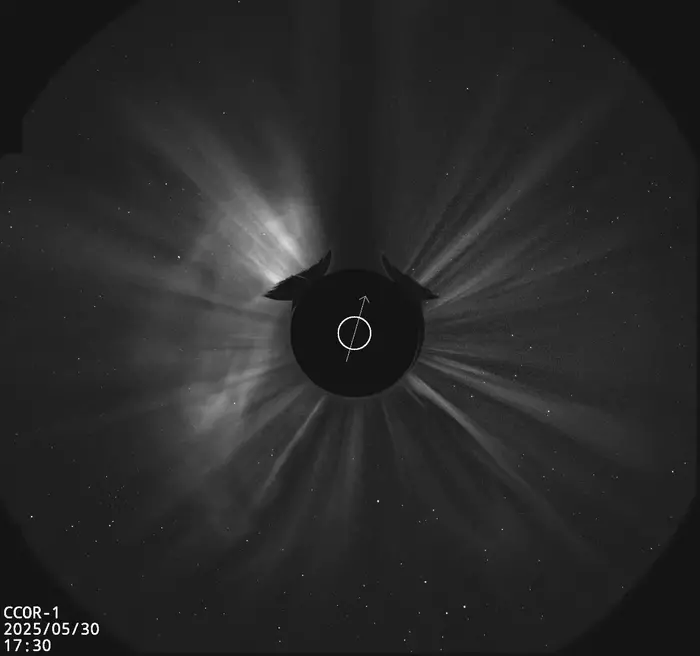On May 31, 2025, the U.S. Naval Research Laboratory (NRL) made a significant breakthrough in space weather observation by capturing real-time imagery of a powerful Coronal Mass Ejection (CME) erupting from the Sun. This celestial phenomenon initiated a severe geomagnetic storm alert for Earth, representing a rare instance where a weather alert applies on a planetary scale rather than just localized conditions. The importance of such observations cannot be overstated as they provide critical data to predict and mitigate potential disruptions to Earth’s technological and communication systems.
The CME in question was classified as a “halo CME,” which signifies that the eruption was aimed directly toward Earth. This classification is based on the preliminary analysis that indicated an extraordinary velocity exceeding 1,700 kilometers per second. Dr. Karl Battams, a computational scientist at NRL’s Heliospheric Science Division, emphasized that the velocity and trajectory of the CME underscored its potential impact on our planet. The ability to capture such high-speed events marks a pivotal advancement in real-time space weather monitoring.
Geomagnetic storms, as defined by the National Oceanic and Atmospheric Administration (NOAA), result from the effective transfer of energy between the solar wind and Earth’s magnetosphere. This transfer can lead to the disruption of various technological systems, making it crucial for space weather forecasters to monitor such events closely. The alert for a G4 storm, which is the second-highest classification on NOAA’s geomagnetic scale, highlights the event’s severity and its implications for both civilian and military operations.
The repercussions of intense geomagnetic storms can be multifaceted, affecting everything from GPS navigation to satellite operations. A powerful CME like the one on May 31 can induce electrical currents in power lines, potentially leading to blackouts and damaging transformers. Military readiness can also be compromised, as precision-guided systems and command and control operations can be severely affected by disruptions in communications and data feeds.
CMEs are colossal expulsions of plasma and magnetic fields from the Sun’s corona, carrying with them an immense volume of material. While they typically take several days to traverse the vast distance to Earth, certain intense CMEs have been known to arrive within as little as 18 hours. Such speed emphasizes the urgency of accurate forecasting and preparedness in mitigating their impacts. The understanding of CMEs’ dynamics is essential for developing models that can predict their behavior as they travel through space.
The events leading up to the May 31 CME included a notable solar flare, releasing vast amounts of energy and launching a CME directly toward Earth. As a result of this storm, spectacular auroras were reported as far south as New Mexico, a phenomenon typically associated with powerful geomagnetic activity. This reflects not only the beauty of such natural occurrences but also the substantial energy released during these solar events.
NRL’s cutting-edge instrumentation played a vital role in observing the CME, with critical data gathered from both the long-standing Large Angle Spectrometric Coronagraph (LASCO) and the newly launched Compact Coronagraph 1 (CCOR-1). This technological arsenal showcases NRL’s commitment to maintaining its leadership in heliophysics research and space weather science, ensuring robust data collection for operational monitoring.
As space weather forecasting becomes increasingly important, the capabilities developed through NRL’s extensive research portfolio continue to evolve. The instruments now active in orbit, including LASCO and CCOR-1, are crucial for producing real-time imagery and analysis that can inform decision makers across various sectors, especially those critical infrastructure sectors relying heavily on technology and connectivity.
Moreover, the significance of real-time imaging cannot be understated. With the precarious nature of Earth’s magnetic environment, timely data enables agencies like the Department of Defense (DoD) and NOAA to issue alerts and warnings that can safeguard both national security and public safety. This interplay between scientific research and practical application is crucial in addressing the growing challenges posed by space weather.
Dr. Arnaud Thernisien from NRL stated that the data collected during events like the May 31 CME enhances our understanding of space weather and its implications on Earth. The ability to predict the timing and potential severity of geomagnetic storms has far-reaching implications. As humanity becomes ever more dependent on technology, the significance of preparing for space weather disruptions grows exponentially.
In conclusion, the remarkable observations from the NRL regarding the May 31 CME not only advance our knowledge of solar activity but also underscore the importance of operational readiness against potential disruptions caused by such events. As scientific understanding continues to evolve, the lessons learned from each CME will play an essential role in shaping not just our reaction to these phenomena but also our proactive measures in safeguarding the technological frameworks that sustain modern society.
Subject of Research: Coronal Mass Ejections and Their Impact on Earth’s Space Weather
Article Title: New Era in CME Research: Observing the May 2025 Coronal Mass Ejection
News Publication Date: October 12, 2023
Web References: https://www.swpc.noaa.gov/
References: NOAA Space Weather Prediction Center documentation, NRL press releases
Image Credits: Credit: NOAA’s CCOR-1
Keywords
CMEs, geomagnetic storms, space weather, satellite disruption, NOAA, solar flares, real-time observation, Earth’s magnetosphere, NRL, heliophysics.




